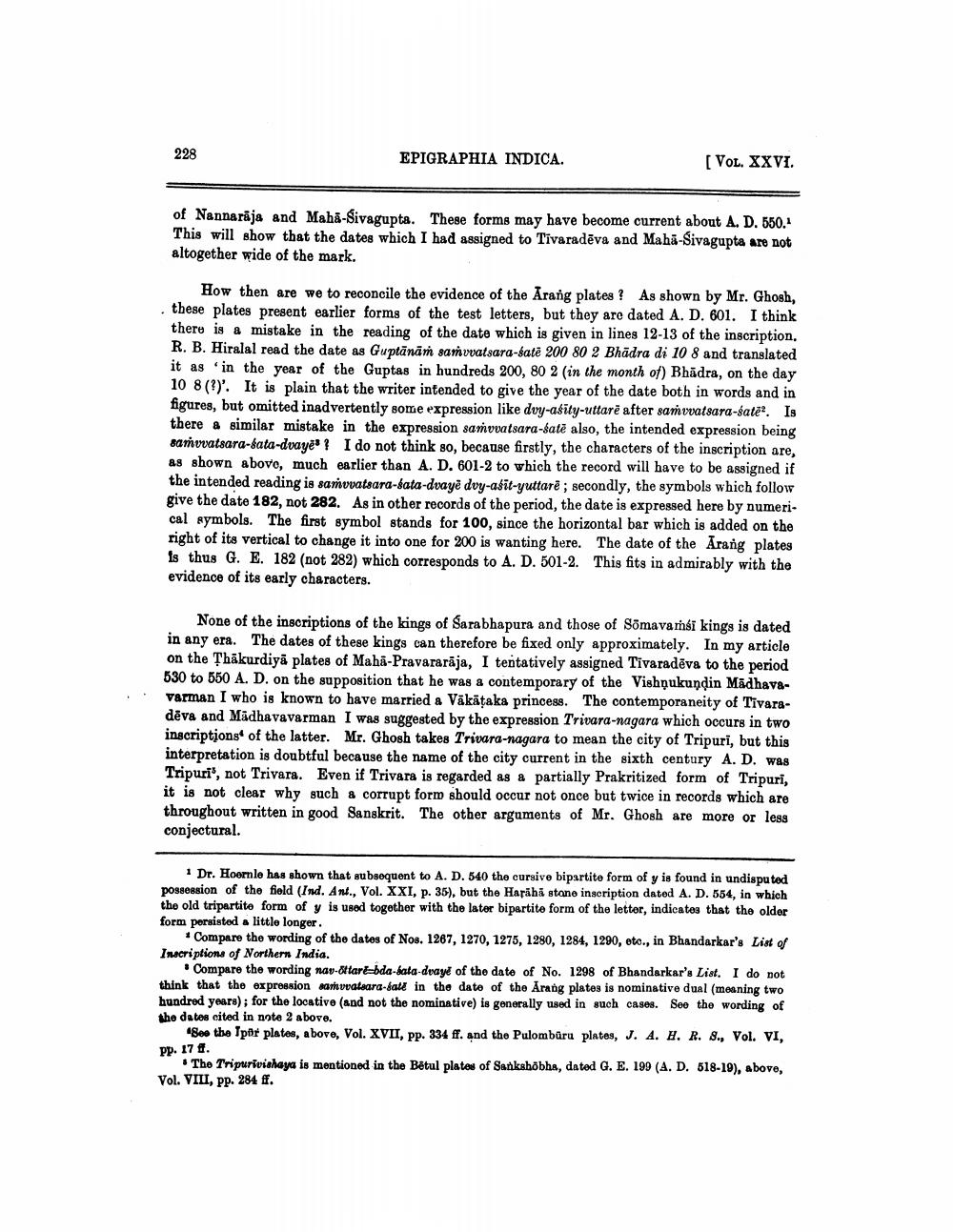________________
228
EPIGRAPHIA INDICA.
[VOL. XXVI.
of Nannarāja and Maha-Sivagupta. These forms may have become current about A. D. 550. This will show that the dates which I had assigned to Tivaradēva and Maha-Sivagupta are not altogether wide of the mark.
How then are we to reconcile the evidence of the Arang plates? As shown by Mr. Ghosh, these plates present earlier forms of the test letters, but they are dated A. D. 601. I think there is a mistake in the reading of the date which is given in lines 12-13 of the inscription. R. B. Hiralal read the date as Guptānām savvatsara-sate 200 80 2 Bhadra di 10 8 and translated it as in the year of the Guptas in hundreds 200, 80 2 (in the month of) Bhädra, on the day 10 8 (?)'. It is plain that the writer intended to give the year of the date both in words and in figures, but omitted inadvertently some expression like dvy-asity-uttarë after samvatsara-satë. Is there a similar mistake in the expression samvvatsara-sate also, the intended expression being samvvatsara-sata-dvayet? I do not think so, because firstly, the characters of the inscription are, as shown above, much earlier than A. D. 601-2 to which the record will have to be assigned if the intended reading is saṁuvatsara-lata-dvayê dvy-asit-yuttare ; secondly, the symbols which follow give the date 182, not 282. As in other records of the period, the date is expressed here by numerical symbols. The first symbol stands for 100, since the horizontal bar which is added on the right of its vertical to change it into one for 200 is wanting here. The date of the Arang plates is thus G. E. 182 (not 282) which corresponds to A. D. 501-2. This fits in admirably with the evidence of its early characters.
None of the inscriptions of the kings of Sarabhapura and those of Somavamsi kings is dated in any era. The dates of these kings can therefore be fixed only approximately. In my article on the Thakurdiyā plates of Maha-Pravararāja, I tentatively assigned Tivaradēva to the period 530 to 650 A. D. on the supposition that he was a contemporary of the Vishņukundin MadhavaVarman I who is known to have married a Vākāțaka princess. The contemporaneity of Tivaradēva and Madhavavarman I was suggested by the expression Trivara-nagara which occurs in two inscriptions of the latter. Mr. Ghosh takes Trivara-nagara to mean the city of Tripuri, but this interpretation is doubtful because the name of the city current in the sixth century A. D. was Tripuri', not Trivara. Even if Trivara is regarded as a partially Prakritized form of Tripuri, it is not clear why such & corrupt form should occur not once but twice in records which are throughout written in good Sanskrit. The other arguments of Mr. Ghosh are more or less conjectural.
1 Dr. Hoernle has shown that subsequent to A. D. 540 the cursive bipartite form of y is found in undisputed possession of the field (Ind. Ant., Vol. XXI, p. 35), but the Hapāhi stano inscription dated A. D. 554, in which the old tripartite form of y is used together with the later bipartite form of the letter, indicates that the older form persistod a little longer.
* Compare the wording of the dates of Nos. 1267, 1270, 1275, 1280, 1284, 1290, etc., in Bhandarkar's List of Inscriptions of Northern India.
Compare the wording nav-oltarbda-lata-dvaye of the date of No. 1298 of Bhandarkar's List. I do not think that the expression avvalera-bald in the date of the Arang plates is nominative dual (meaning two hundred years); for the locative (and not the nominative) is generally used in such cases. See the wording of the dates cited in note 2 above.
"See the Ipor plates, above, Vol. XVII, pp. 334 ff. and the Pulombūru plates, J. A. H. R. 8., Vol. VI,
Pp. 178.
** The T'ripurivishaya is mentioned in the Betul plates of Sankshobha, dated G. E. 199 (A. D. 518-19), above, Vol. VIII, pp. 284 ff.




